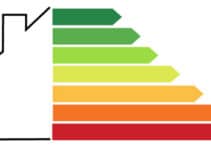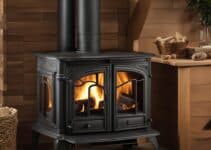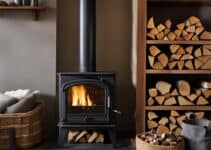As a conscientious homeowner contemplating the installation of a log burner, my primary concern extends to selecting the most suitable and efficient log burner flue types. Now, with varied options on the market, it’s imperative to delve into the intricacies of log burner flue installation, seeking out the best type of flue for log burner that aligns precisely with my home’s chimney configuration.
Understanding that the safety and performance of my log burner are directly tied to the flue I choose, I am committed to exploring all available flue types. This thorough assessment guarantees that I adopt a solution that not only meets regulatory standards but also upholds the efficiency and longevity of my heating system.
Understanding the Role of a Flue in Log Burners
As an aficionado of cosy home heating, I recognise the indispensable role that a properly constructed and installed flue plays in the safety and efficiency of a log burner. A flue, or log burner flue liner, isn’t merely an accessory; it’s an essential component that enables your log burner to operate at peak performance while adhering to log burner flue regulations, and ensuring your peace of mind.
Defining a Flue
A flue is fundamentally the conduit nestled within the chimney that expels the smoke and gases resulting from your log burner. Without this vital pathway, not only would the combustion by-products of your fireside retreats be misdirected, the very structure of your home could be compromised by the corrosive nature of those emissions. Selecting the correct log burner flue kit is thus a decision that bears significantly on both functionality and longevity.
The Importance of Flue Types Based On Your Chimney
My extensive experience has taught me that the choice of a log burner flue liner is dictated by the architecture of your existing chimney. For example, in the quaint chimneys typical of homes predating the 1960s, you’d commonly find a requirement for flexible metal log burner flue liners, designed to provide the necessary insulation within the broad but drafty stacks of yesteryear. Conversely, in more modern homes that lack a traditional chimney altogether, the ingenious solution lies in a twin-wall flue system. This alternative mimics a chimney’s function and matches the log burner flue height standards required for safe and efficient use.
| Type of Home | Chimney Presence | Recommended Flue Type | Special Considerations |
|---|---|---|---|
| Pre-1960s | Class 1 Chimney | Flexible Metal Flue Liner | Enhanced insulation necessary |
| Modern, No Chimney | Absent | Twin-Wall Flue System | Mimics chimney effect, adheres to flue height regulations |
| Post-1960s, Precast Chimney | Limited | Specific Gas-Powered Log Burner Models | Shallow and narrow flues; wood burners not recommended |
Ensuring the log burner flue installation is carried out meticulously according to your home’s specifications can’t be overstated, for it’s within these details that the secret to a safe, warm, and pleasant environment lies. Observing strict log burner flue regulations is more than adherence to rules; it’s about crafting a space where warmth and safety are in perfect harmony.
Identifying Your Chimney Type for the Best Flue Choice
As a devoted connoisseur of the warmth and ambience that a log burner brings to a home, I recognise the critical importance of pairing it with the perfect flue. This decision pivots on correctly identifying your chimney type. In the UK, the compatibility of log burner flue types with existing chimney structures is deeply intertwined with the architecture of a residence.
In my professional experience, discerning your home’s chimney category is the initial step towards a successful installation. Class 1 chimneys, often found in older constructions, exhibit a penchant for lime mortar lining, making them prime candidates for a flexible metal flue liner. Meanwhile, modern dwellings tend to have precast chimneys, which impose certain constraints on log burner usage due to their size and construction design. In scenarios where a chimney isn’t present, the innovation of a twin-wall flue system comes into play, providing a feasible option for safely implementing a log burner.
To shed further light, here is a table elucidating the optimal flue diameters against common chimney types:
| Chimney Category | Recommended Flue Diameter | Suitable Flue Type |
|---|---|---|
| Class 1 with Lime Mortar Lining | 6 inches (152mm) | Flexible Metal Flue Liner |
| Precast Chimneys in Newer Homes | Limited Application | Twin-wall Flue Systems |
| Non-existent Chimney | 5 or 6 inches (125mm or 152mm) | Twin-wall Flue Systems |
A chimney sweep, armed with vast expertise, can be your indispensable ally in discerning the specific type of chimney you possess. Their insights will lead you to select not just any flue but the definitive log burner flue diameter and type that harmonises perfectly with your cherished wood-burning stove.
Best Type of Flue for Log Burner According to Chimney Category
When it comes to optimising the performance and safety of a log burner, the importance of selecting a suitable flue cannot be overstated. My analysis is focused on identifying the best flue solutions based on the chimney category present in one’s home. By aligning the chimney infrastructure with the correct type of flue, homeowners can ensure their log burners operate efficiently and comply with necessary standards.
Class 1 Chimney Solutions
I advise homeowners with Class 1 chimneys to opt for a flexible metal log burner flue liner. This choice significantly enhances the chimney’s insulation, leading to better efficiency and reliable operation of the log burner. It is essential that this flue liner matches the log burner’s stove-pipe diameter and is composed of the right material – 316-grade stainless steel is ideal for burning wood exclusively, while the more robust 904 grade is suited for mixed fuel usage.
Adapting to Homes without Chimneys
For homes without an existing chimney, the installation of a twin-wall flue system is a superior alternative. This type of log burner flue kit ensures effective draw and insulation, maintaining the smoke temperature to bolster both efficiency and safety of the log burner. Its cleverly designed interlocking mechanism allows for both internal and external installations, contributing to creating a robust ‘chimney effect’ that is needed for the log burner’s operation.
| Flue Type | Best Use | Material | Installation |
|---|---|---|---|
| Flexible Metal Flue Liner | Class 1 Chimney | 316 grade (wood), 904 grade (mixed fuels) | Within existing chimney structure |
| Twin-Wall Flue System | Homes without chimneys | Stainless steel with insulation | Internal or External installation |
Through meticulous log burner flue installation and the utilisation of the appropriate log burner flue kit, homeowners can enjoy the warmth and comfort of their log burner whilst adhering to the high standards of functionality and safety.
Navigating Log Burner Flue Regulations and Safety Measures
Installing a log burner in one’s home invites the cosy ambience of a crackling fire, yet brings with it the imperative to strictly adhere to log burner flue regulations. My professional insights into the installation process consistently highlight the critical nature of complying with specific legal standards, especially regarding log burner flue height and flue installation clearances from combustible materials. These regulations are in place to ensure safe and efficient operation, as well as to mitigate any potential fire hazards.
One of the key aspects of these regulations is the stipulated height of the log burner’s flue. It must extend well above the roofline to ensure smoke and embers are adequately dispersed and do not present a risk to the property or nearby buildings. The exact height requirement can vary based on the location and design of the building, but exceeding the minimum is often recommended for better draw and performance.
In the realm of safety measures, twin-wall flues are often preferred over single-wall flues due to their superior insulation properties. Twin-wall flues are designed to be installed closer to combustible materials, a feature that widens their application within various architectural confines. This versatility is not the case for single-wall flues, which must adhere to stricter installation parameters to avoid proximity to potentially flammable structures.
For those considering the installation of a log burner flue, the following list outlines several key measures that must not be overlooked:
- Verification of flue height compliance as per local building regulations
- Selection of appropriate flue type (single-wall or twin-wall) based on proximity to combustible materials
- Ensuring that the flue installation is carried out by a certified professional to guarantee adherence to all safety standards
- Regular maintenance checks post-installation for any signs of obstruction or wear that could impede safe operation
It is through diligent observation of these regulations and safety procedures that we can appreciate the warmth and charm of a log burner, safe in the knowledge that every precaution has been taken to protect our homes and loved ones from potential hazards.
Selection Criteria for Log Burner Flue Size and Material
Identifying the appropriate log burner flue size and selecting the optimal flue material is an essential part of ensuring efficient and safe operation of your log burner. This selection is not just a matter of compatibility; it is a complex decision with direct implications on the burner’s functionality and longevity.
Effects of Flue Diameter on Log Burner Efficiency
The log burner flue diameter should be an exact match to the log burner’s stove-pipe size to maintain the efficiency of the system. A mismatch in size could result in inadequate draft and suboptimal combustion, leading to potential safety concerns. Commonly, flue liners come in diameters of five or six inches, but always refer to the manufacturer’s specifications to ensure the correct log burner flue size is selected.
Material Choices for Flue Liners: 316 vs 904 Grade
When it comes down to log burner flue material, the choices are typically narrowed to 316 or 904 grade stainless steel liners. Each type is designed to meet different burning requirements: 316 grade is suitable for burning wood exclusively, while 904 grade should be used with log burners that are designed for both wood and solid fuels. The decision hinges on the specific fuel types planned to be used in your log burner.
| Flue Liner Material | Compatibility | Advantages | Typical Usage |
|---|---|---|---|
| 316 Grade Stainless Steel | Wood Only | Cost-efficient, durable for wood smoke | Traditional wood log burners |
| 904 Grade Stainless Steel | Wood and Solid Fuels | Resistant to high acidity, longer lifespan | Multifuel and boiler stoves |
Opting for the correct log burner flue liner and selecting the best-suited flue material will significantly enhance your log burner’s efficiency and ensure a safe and warm environment for your home.
Conclusion
In summing up, the journey to identify the best type of flue for a log burner is a matter of careful consideration of several key factors. As we’ve explored, the specific type of chimney your home possesses plays a fundamental role in determining the appropriate flue. Whether it’s a flexible metal flue that snugly fits into a traditional class 1 chimney, or a resilient twin-wall flue system designed for homes lacking a chimney, matching the right type to your situation is vital for both performance and safety.
Moreover, one must not overlook the importance of correct flue material and sizing. These elements are critical to the safe and efficient use of a log burner. For me, ensuring compatibility between the log burner’s specifications and the flue installation is not merely a recommendation—it’s an imperative. By engaging with professionals in the field and understanding the intricacies of flue liner materials and regulations, you ensure a high-quality installation that adheres to all safety guidelines.
Ultimately, a log burner is more than a heating element; it’s a centerpiece that brings warmth and character to a home. It is my hope that this article has illuminated the pathway to securing the ideal log burner flue types and installations, providing you with the confidence to make an informed choice. A choice that guarantees an efficient, compliant, and most importantly, a delightful addition to your living space.



